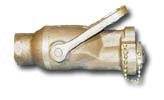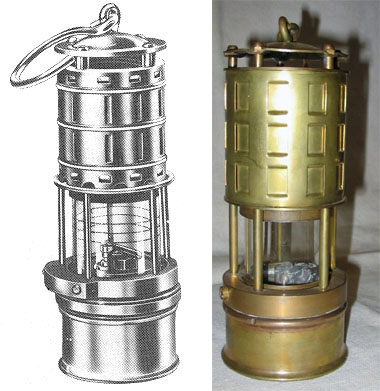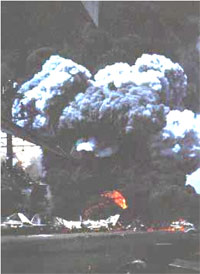 |
 |
 |
 |
| HOME |
| ABOUT US |
| PARTICIPATE |
| COLLECTIONS |
| DC EQUIPMENT MUSEUM |
| SHIP&SUBMARINE MUSEUM |
| WW II DAMAMGE REPORTS |
| SHIPBOARD CASUALTIES |
| DAMAGE CONTROL MUSEUM | ||
|
USS FORRESTAL (CV 59), Fire, 9 October 1989 |
||
|
USS FORRESTAL
Description: ZUNI rocket accidentally fired through the fuel tank of an aircraft, rupturing the tank and igniting the spilled fuel. This fire in turn cooked off a 1000-pound bomb. The bomb explosion ruptured other aircraft fuel tanks and spread the fire across a large area to other aircraft on the after end of the ship. Seven major explosions then occurred. The force of the exploding flight deck ordnance penetrated to the hangar bay and initiated fires on the 03, 02 and 01 levels aft. Fuel spilled from the damaged aircraft, setting fires on the sides, sponson and fantail, as well as fueling fires in the hangar bay. Summary of Events and Causal Factors: The ship was engaged in high tempo combat operations against targets in North Vietnam and had been operating on station for four days without suffering any casualties. The ship was in a high state of readiness and had received top grades during its work-ups prior to deployment. However, no major flight deck or hangar bay fire training had been conducted during the work-ups. The primary flight deck fire parties were certified, but no backups were identified or trained. Forrestal was in material condition YOKE, which had been checked three hours prior to the fire, and was preparing for a bombing strike on the Vietnam mainland. The aircraft on deck were crowded together, each with a full load of bombs, rockets and JP-5 aircraft fuel. As engine start-up commenced, an errant five-inch rocket fired from an LAU-10A launcher on the port inboard wing station of an F-4 fighter aircraft. (The probable causes of ZUNI rocket firing were human error and material failure.) The rocket crossed the flight deck, struck a crewmember, then hit a fully loaded 400-gallon fuel tank on an A-4 aircraft 100 feet away. The tank burst into flames, igniting the entire aft section of the carrier's deck. The burning fuel was spread aft and fanned by 32-knot winds over the deck and by the exhaust of at least three jets spotted on deck just forward of the conflagration. Approximately 53 seconds after the fire started, one firefighter with a portable PKP extinguisher ran toward a plane in an attempt to save a pilot. Other personnel manned high capacity fog, foam and salt-water hoses on catwalks. Other flight deck leaders directed their men to approach the fire with single foam lines. Ninety seconds after the start of the fire, however, the first bomb thermally detonated. Nine seconds later, a second bomb exploded with more violence than the first. These explosions complicated rescue and firefighting efforts to a crippling degree. Twenty-seven personnel in the fire parties were killed or injured, thus decimating the front line capability on the flight deck. New flight deck leaders took charge and formed new fire parties, attacking the fires and jettisoning ammunition, burning wreckage and bombs over the side (as shown in Figure 3-2). However, since many of these new fire team members were untrained and unfamiliar with the equipment, progress was slow and sometimes dangerous. At one point, two parallel fire parties, one with foam and one with water, attacked the same aircraft fuel fire. As the foam team covered the flames and moved forward, the water team attempted to augment the effort and instead washed away the foam, causing a reflash and injuring several of the foam team members. Survivability Principles Applied: Forrestal arrived onstation with a qualified, confident crew. However, the crew's work-up had not included massive conflagration training and therefore the ship was not prepared for the catastrophe it suffered. Firefighting teams were skilled but did not have qualified replacements in the event of casualties to primary team members. Replacement crewmembers, who had to man firehoses and jettison gear, were not familiar with proper firefighting procedures, systems or personnel protection equipment and were, therefore, sometimes counterproductive in their efforts. Additionally, egress training was not sufficient, a fact which contributed to crewmembers being trapped in their berthing compartments immediately after the initial explosion. There were equipment shortcomings as well. The only firefighting equipment available on the flight and hangar decks were portable fire extinguishers and 2.5-inch hose lines dispensing protein foam. Information ascertained from this incident led to several damage control improvements:
After the Forrestal fire, the feasibility of converting the flight deck washdown system to a firefighting system was investigated and executed. This included placing "zone" control buttons for discrete ship regions, including the flight deck, in both primary flight and navigation bridges. A typical carrier flight deck today is divided into 15 zones, each having the capability of discharging 1000 gallons of AFFF per minute. These implemented lessons learned enable present-day carriers to control Forrestal-type conflagrations within minutes by using AFFF in the washdown system. Additionally, fire pump management and personnel protection are now stressed when training new recruits to combat conflagrations or basic fires. Despite the many incidents of personal bravery and professionalism by the ship's crew, it was beyond the power of humans or machines to stop the onrush of burning fuel and exploding ordnance. Adequate means to deal with such a mass conflagration simply were not available. Despite weaknesses in the areas of preparation and practice, the significant elements of professionalism and persistence solidified by strong leadership eventually overcame the casualties and saved the ship. Several sailors who were interviewed following the event believed their ship could not be destroyed by the fires they faced and, thus, if they pressed their efforts, they would eventually extinguish the conflagration. This positive attitude - which has also been called perception - influenced their efforts and led to a successful conclusion. |
||
